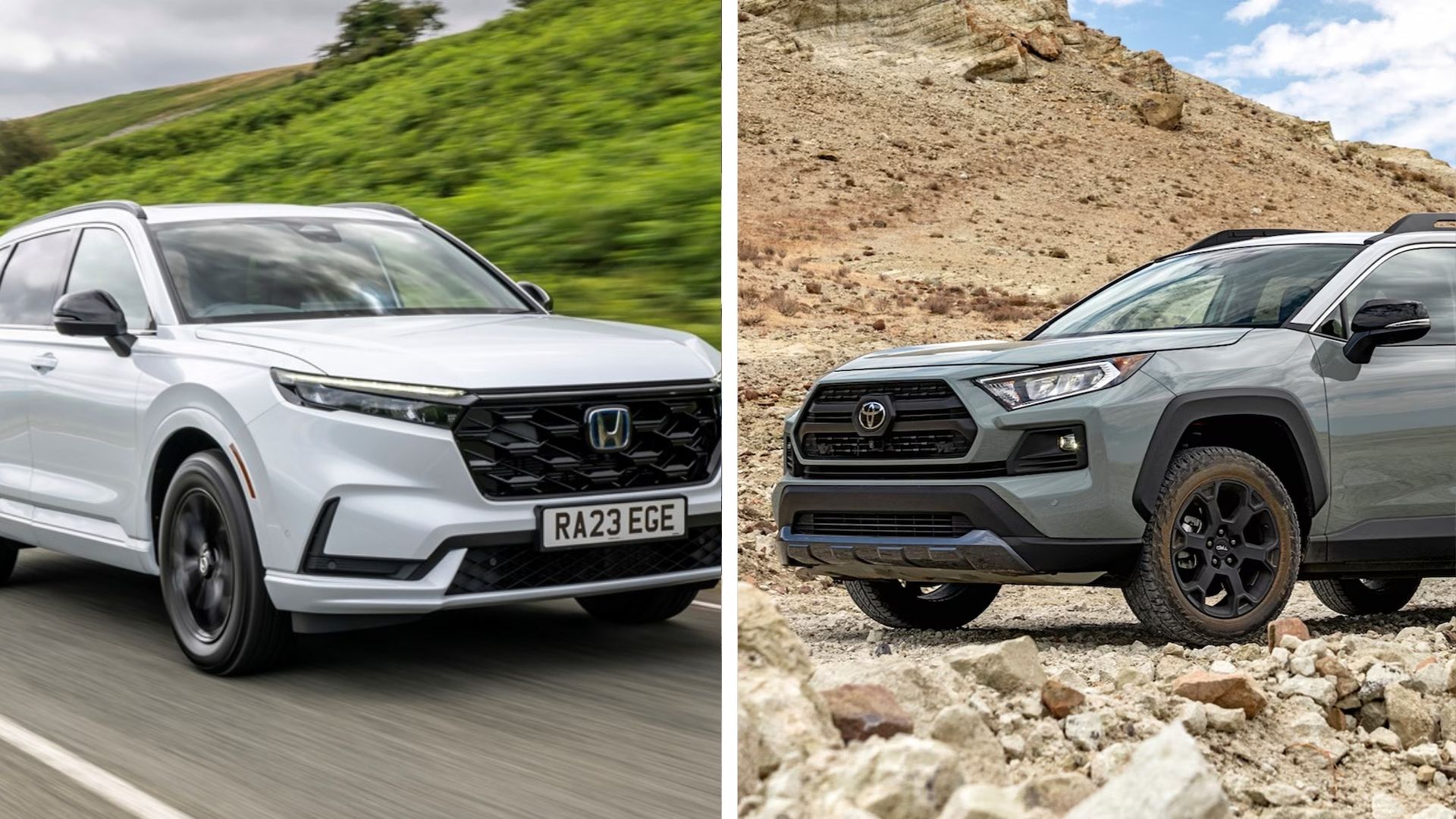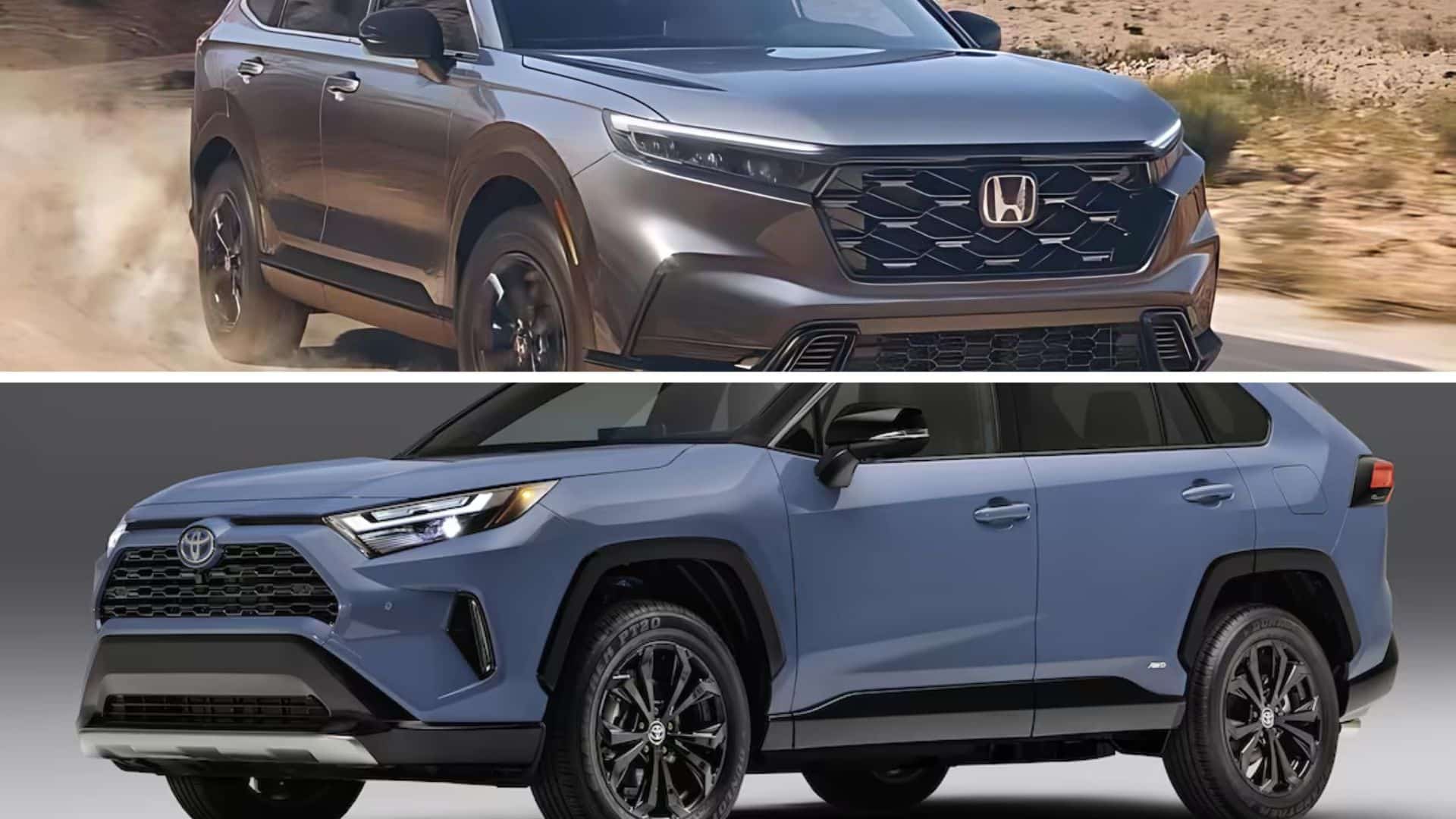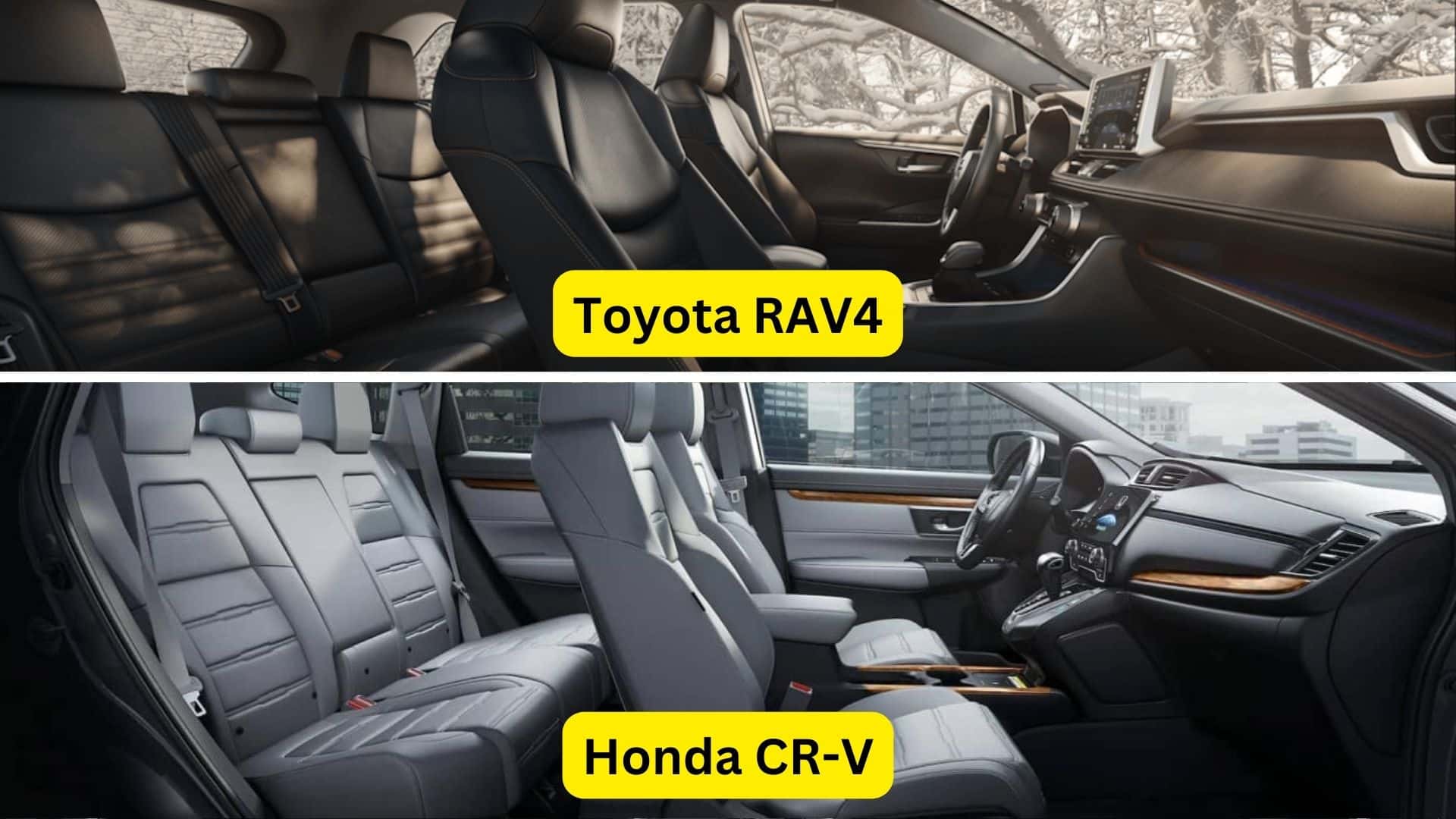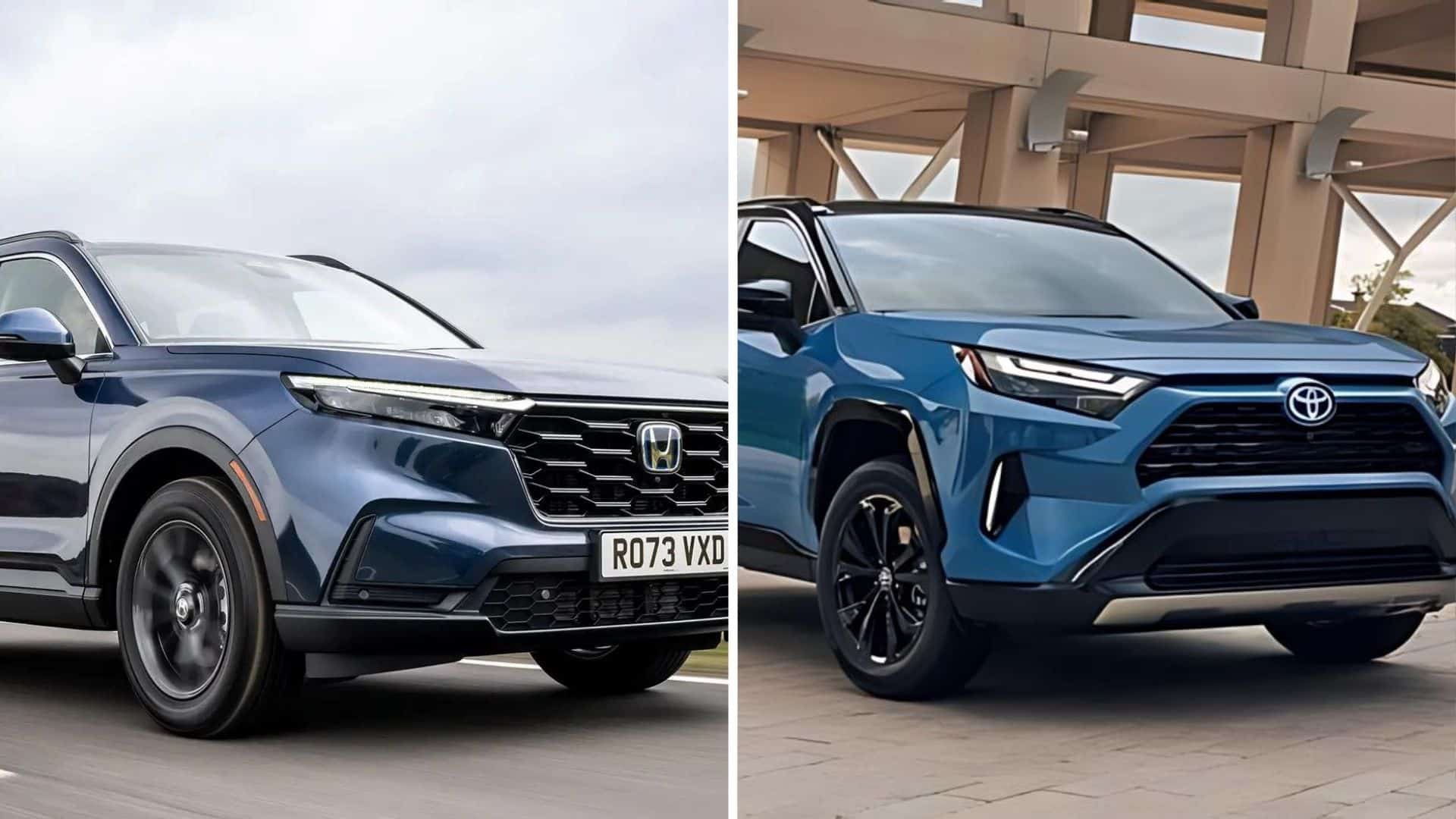Compact SUV shoppers often compare the RAV4 vs CR-V, two of the most popular choices in this competitive segment.
Both vehicles offer a compelling mix of comfort, practicality, and efficiency that appeals to many drivers.
However, choosing between these dependables can be challenging, as each has strengths and unique features.
This comprehensive analysis will break down the key aspects of the Toyota RAV4 and Honda CR-V, including performance, fuel economy, interior space, technology, and safety features.
By examining these factors in detail, we aim to give you the insights needed to make an informed decision.
Whether you prioritize off-road capability, fuel efficiency, or advanced tech features, our comparison will help you determine which of these well-rounded SUVs best suits your needs.
RAV4 vs CR-V
This section will explore the origins and key characteristics of the Toyota RAV4 and Honda CR-V.
Understanding their history and core features provides context for their current market positions in the RAV4 vs CR-V comparison.
The Toyota RAV4
The Toyota RAV4, first introduced in 1994, has long been a favorite in the compact SUV market.
Known for its tough looks and versatility, the RAV4 has evolved significantly while maintaining its core appeal.
Toyota offers various trims and configurations, catering to multiple driver preferences and needs.
From the budget-friendly LE to the off-road-ready TRD Off-Road, the RAV4 lineup provides options for city residents and adventure seekers.
This variety allows buyers to find an RAV4 that fits their lifestyle, whether they prioritize fuel efficiency, performance, or outdoor capabilities.
The Honda CR-V
Debuting in 1997, the Honda CR-V quickly established itself as a strong competitor in the compact SUV segment.
The CR-V has built a reputation for its spacious interior and smooth handling, making it a top choice for families and commuters.
Honda recently redesigned the CR-V, giving it a more modern look and improved features. This refresh has enhanced the vehicle’s appeal, updating its technology and safety offerings while maintaining the practicality that CR-V owners have expected.
The latest generation boasts a refined cabin, improved fuel efficiency, and a range of driver-assist features, further solidifying its position as a leading option in the compact SUV market.
Performance

When comparing the RAV4 vs CR-V, performance is a key factor. This section examines engine specifications, transmission types, and driving dynamics to help you understand how these SUVs behave on the road.
1. Engine Specifications
The Toyota RAV4 has a 2.5-liter inline-4 engine, generating 203 horsepower and 184 lb-ft of torque.
This naturally aspirated engine provides strong, consistent power across the rev range. In contrast, the Honda CR-V features a smaller 1.5-liter turbocharged inline-4 engine, producing 190 horsepower and 179 lb-ft of torque.
While the CR-V’s engine has lower output on paper, its turbocharger helps deliver power more quickly in everyday driving situations.
2. Transmission
Toyota pairs the RAV4 with an 8-speed automatic transmission. This traditional gearbox offers distinct shift points and can create a more engaging driving experience.
The Honda CR-V, on the other hand, uses a Continuously Variable Transmission (CVT). While CVTs are known for their smooth operation and fuel efficiency, some drivers may find the lack of gear changes less exciting.
3. Driving Dynamics
The RAV4 offers a more rugged driving experience, especially in its off-road-oriented trims, such as the Adventure and TRD Off-Road.
These versions come with enhanced suspension and all-wheel-drive systems, making them capable of handling rougher terrain.
While not as off-road focused, the CR-V shines in everyday driving scenarios. It offers smoother handling, a quieter ride, and more car-like dynamics, which many drivers find appealing for daily commutes and family trips.
Fuel Economy

Fuel economy is a crucial factor for many buyers in the RAV4 vs. CR-V comparison. This section breaks down the efficiency ratings for standard and hybrid models, helping you understand potential fuel costs and environmental impact.
City/Highway Miles Per Gallon
The Toyota RAV4 with front-wheel drive (FWD) achieves an impressive 28 mpg in the city and 35 mpg on the highway.
The Honda CR-V FWD matches the RAV4’s city rating at 28 mpg but falls slightly behind on the highway with 34 mpg.
When equipped with all-wheel drive (AWD), both SUVs see a small decrease in efficiency. The RAV4 AWD delivers 27 mpg in the city and 33 mpg on the highway, while the CR-V AWD manages 27 mpg city and 32 mpg highway.
These figures show that both vehicles offer competitive fuel economy, with the RAV4 having a slight edge in highway driving.
Hybrid Options
Toyota and Honda recognize the growing demand for more fuel-efficient vehicles and offer hybrid versions of the RAV4 and CR-V.
These hybrid models provide even better fuel economy than their conventional counterparts, making them attractive options for eco-conscious drivers or those seeking to reduce fuel costs.
The specific mpg ratings for hybrid models can vary depending on trim levels and drivetrain configurations, but they generally offer significant improvements over the standard gasoline engines.
Interior Quality and Comfort

Drivers and passengers spend most of their time in the interior, making it crucial in the RAV4 vs. CR-V debate.
This section examines these popular SUVs’ design, comfort, and practicality.
1. Design and Materials
The Toyota RAV4’s interior focuses on practicality and durability. Its materials are chosen for longevity and ease of maintenance, which appeals to those prioritizing function over luxury.
However, some may find the overall feel less upscale compared to competitors. The Honda CR-V, in contrast, offers a more refined interior with higher-quality materials and a modern design aesthetic.
The CR-V’s cabin features softer touch points and a more premium feel, especially in higher trim levels, making it more appealing to those seeking luxury in their compact SUV.
2. Space and Comfort
Both SUVs offer ample space, but there are notable differences. The RAV4 provides sufficient room for passengers, but its rear seating has been criticized for being less comfortable on longer journeys.
The CR-V excels in this area, offering more spacious and comfortable rear seats with better legroom.
This makes the Honda a strong choice for families or those frequently traveling with rear-seat passengers.
The CR-V’s additional space and comfort can significantly affect overall passenger satisfaction, especially on extended trips.
3. Cargo Capacity
Both vehicles are competitive when it comes to cargo space, but the CR-V has a slight edge. The RAV4 offers 37.6 cubic feet of cargo space behind the rear seats, which expands to 69.8 cubic feet with the rear seats folded down.
The CR-V provides even more room, with 39.3 cubic feet behind the rear seats and 76.5 cubic feet with the seats folded.
This additional space in the CR-V can be particularly useful for those who frequently carry large items or need maximum versatility from their SUV.
Technology and Infotainment

Technology and infotainment features play a significant role in the RAV4 vs CR-V comparison in today’s connected world.
This section explores the digital offerings of both SUVs, highlighting their strengths and differences.
The Toyota RAV4
The RAV4 comes standard with an 8-inch touchscreen infotainment system, which is user-friendly and responsive.
Higher trims offer an upgraded 10.5-inch screen, providing a more immersive experience. All RAV4 models include Apple CarPlay and Android Auto compatibility, allowing seamless smartphone integration.
Toyota also offers a premium JBL audio system on higher trims, enhancing the audio experience.
The RAV4’s infotainment system is feature-rich, with options like built-in navigation and a Wi-Fi hotspot available on certain models.
While some users find the interface slightly cluttered, the system generally receives positive feedback for its functionality and range of features.
The Honda CR-V
Honda equips the CR-V with a 7-inch touchscreen as standard, with an available 9-inch screen on higher trims.
Like the RAV4, the CR-V includes Apple CarPlay and Android Auto compatibility across all models.
The CR-V’s infotainment system is praised for its straightforward interface and ease of use. While it may not have as large a screen as the top-tier RAV4, many users appreciate its simplicity and responsiveness.
The CR-V also offers features like wireless charging and a premium audio system, though it doesn’t have as many high-end audio options as the RAV4.
Overall, the CR-V’s system focuses on user-friendliness and essential features rather than overwhelming users with too many options.
Safety Features

When comparing the RAV4 vs CR-V, safety is a top priority for many buyers. This section examines both SUVs’ standard safety systems and official safety ratings, helping you understand how they protect you and your passengers.
Standard Safety Systems
Toyota and Honda have invested significantly in safety technology, equipping their compact SUVs with a comprehensive suite of driver-assistance features.
The RAV4 comes with Toyota Safety Sense 2.5, while the CR-V is equipped with Honda Sensing.
These systems include automatic emergency braking, which can detect potential collisions with vehicles or pedestrians and apply the brakes if needed.
Lane-keeping assist helps drivers stay centered, reducing the risk of unintended lane departures.
Adaptive cruise control maintains a set distance from the vehicle ahead, adjusting speed automatically in highway driving.
Both SUVs offer additional features like blind-spot monitoring and rear cross-traffic alert on higher trims.
Safety Ratings
Regarding official safety ratings, the RAV4 and CR-V perform exceptionally well. The Toyota RAV4 has earned a Top Safety Pick rating from the Insurance Institute for Highway Safety (IIHS), demonstrating its strong crash protection and avoidance capabilities.
The Honda CR-V goes further, achieving the highest IIHS rating of Top Safety Pick+. This slight edge for the CR-V indicates superior performance in certain crash tests or headlight evaluations.
However, it’s important to note that both vehicles offer excellent safety performance overall, providing peace of mind for drivers and passengers alike.
Pricing and Value
When considering the RAV4 vs CR-V, understanding their pricing and value proposition is crucial.
This section breaks down these popular compact SUVs’ base prices, trim levels, and overall value.
Base Prices
The Toyota RAV4 has a slight starting price edge, with a base MSRP of $28,675 for the LE trim. On the other hand, the Honda CR-V begins at $29,500 for its base model.
While this $825 difference may seem small, it can be significant for budget-conscious buyers.
However, it’s important to consider what features come standard at these price points and how they align with your needs.
Trims and Options
Toyota offers a wider range of RAV4 trims, including the LE, XLE, XLE Premium, Adventure, and TRD Off-Road.
This variety allows buyers to choose an RAV4 that fits their lifestyle and budget. The Adventure and TRD Off-Road trims cater to those seeking more rugged, off-road capable SUVs.
Each step up in trim level adds more features and amenities, with prices increasing accordingly.
While the CR-V offers fewer trim options, each trim is well-equipped. Honda’s approach is to provide comprehensive features at each level, reducing the need for extensive option packages.
This can simplify the buying process and offer better value for those who prefer a more straightforward selection.
When evaluating value, consider factors beyond the price tag, such as fuel efficiency, maintenance costs, resale value, and how well each vehicle’s features align with your specific needs and preferences.
Final Words
In the RAV4 vs CR-V comparison, both SUVs are excellent choices in the compact market. The RAV4 stands out with its rugged styling, off-road capabilities, and slightly lower starting price.
It’s ideal for those seeking adventure and versatility. With its refined interior, superior cargo space, and top safety ratings, the CR-V appeals to families and comfort-oriented drivers.
Ultimately, your decision will depend on personal priorities. If you value a more diverse trim range and off-road prowess, the RAV4 might be your pick.
The CR-V could be the better choice for those prioritizing interior comfort and cargo space. We recommend test-driving both vehicles to get a feel for their unique characteristics.
Whichever you choose, you’ll get a reliable, well-equipped SUV that can serve your needs for years.


